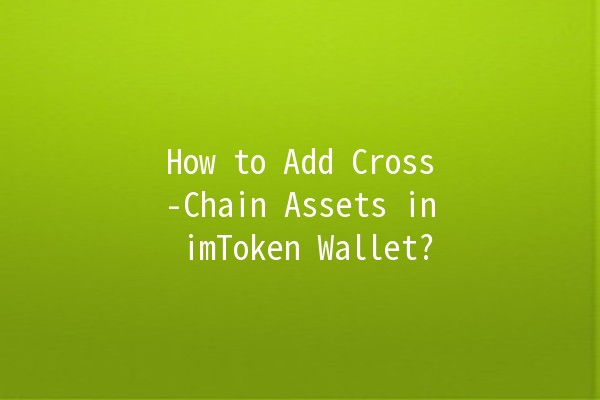The imToken wallet has gained significant traction among cryptocurrency users due to its userfriendly interface and robust security features. As decentralized finance (DeFi) evolves, the ability to manage crosschain assets is increasingly crucial for maximizing investment potential. This article will guide you through adding crosschain assets to your imToken wallet, detailing specific productivityenhancing techniques to simplify the process and enhance your digital asset management.
Crosschain assets refer to cryptocurrencies that exist on multiple blockchain networks. These assets can be transferred seamlessly between different platforms, enhancing liquidity and offering more trading opportunities. For instance, Bitcoin (BTC) can be represented as wrapped BTC (WBTC) on the Ethereum blockchain, allowing users to leverage Bitcoin's value within Ethereum's DeFi ecosystem.
The imToken wallet simplifies the management of various cryptocurrencies, including crosschain assets. Using crosschain assets can offer the following benefits:
Access to Diverse Markets: Crosschain transactions allow users to operate within multiple ecosystems.

Increased Liquidity: Users can swap assets across chains, potentially capitalizing on price differences.
Enhanced Investment Opportunities: Enabling the integration of various digital assets increases overall portfolio versatility.
Adding crosschain assets to imToken involves several key steps. Here are the main methods to manage crosschain assets efficiently.
The imToken wallet features a builtin swap functionality that allows users to exchange one cryptocurrency for another, including crosschain transactions.
Example: If you want to swap Ethereum (ETH) for Binance Coin (BNB), select ETH in the "From" section and BNB in the "To" section. The wallet will present a live conversion rate, allowing for informed decisionmaking.
Tip: Regularly check market rates before swapping. Utilize cryptocurrency tracking apps to stay informed about price fluctuations.
Many DeFi platforms allow users to lock their assets in one chain and receive wrapped tokens or crosschain assets on another.
Example: If using a platform such as AnySwap, you can convert your BTC into wrapped BTC (WBTC) on Ethereum.
Tip: Engage with reputable DeFi protocols with a strong security track record to mitigate risks.
Token bridges are essential tools designed to facilitate the transfer of assets between different blockchains effortlessly. They help you convert tokens into their respective crosschain equivalents.
Example: Use Anyswap to convert your TRC20based assets to ERC20based tokens seamlessly for use in the Ethereum ecosystem.
Tip: Stay aware of transaction fees when using bridges, as costs may vary based on network congestion.
Crosschain decentralized exchanges (DEXs) facilitate the trading of assets across various blockchain networks. These platforms often have liquidity pools providing users with enhanced opportunities.
Example: Swap BTC for ETH using a crosschain DEX allowing both assets for trade. This process enables instant trading without the need for intermediaries.
Tip: Review the DEX’s governance and liquidity before participating to ensure the platform is trustworthy.
If you acquire crosschain assets that aren’t automatically recognized by imToken, you can manually add them as custom tokens.
Example: If you acquire a new DeFi token that does not appear in the wallet, input its contract address to monitor your holdings.
Tip: Always verify the token's legitimacy through trusted sources to avoid scams.
Crosschain assets include various cryptocurrencies and tokens, such as wrapped Bitcoin (WBTC), ERC20 tokens on Ethereum, and BEP20 tokens on Binance Smart Chain. Always ensure the assets are compatible with the imToken wallet.
Token bridges are generally safe when used with reputable platforms, but they are associated with risks like smart contract vulnerabilities. Research and choose bridges with strong security audits.
Transaction fees within imToken can vary based on the asset being swapped and the current network congestion. You can view transaction fees dynamically through the imToken app or on the respective blockchain explorer.
If a transaction fails on a decentralized exchange or bridge, assets typically remain in your wallet. However, you might need to resubmit the transaction, ensuring that you have accurate recipient details.
Custom tokens must be added manually through the contract address. If you’ve added the contract address correctly, ensure the network and asset type match those used for the token.
Interacting with crosschain assets can involve several risks, including smart contract exploits, high network fees, and reliance on the security of the bridging platforms. Always use trusted services and understand the associated risks.
Managing crosschain assets in imToken involves not just adding assets but also improving overall productivity. Here are five strategies to enhance your efficiency:
By integrating portfolio tracking tools, you can gain insights into the performance of your crosschain assets, allowing you to make informed decisions.
Implement alerts through specialized apps to notify you of substantial price changes in your preferred assets. This allows timely actions for trading or leveraging arbitrage opportunities.
Perform routine checks on the distribution of your digital assets. This helps you maintain balanced risk levels and capitalize on underperforming investments.
Stay informed on market trends, DApps, and protocols through news aggregators and social media. Being wellinformed allows you to respond swiftly to market changes.
Join online forums or Discord communities that discuss crosschain trends. Learning from peers and experts can enhance your knowledge and tactical approaches.
Having a streamlined process for adding crosschain assets in your imToken wallet gives you a significant advantage in navigating the cryptocurrency landscape. Remember to stay vigilant about the risks and market dynamics, and use productivityenhancing tools and strategies to your advantage.